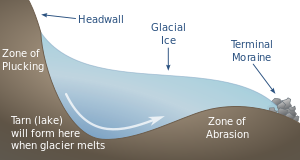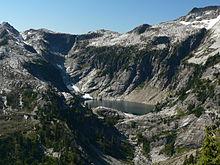- Cirque
-
For other uses, see Cirque (disambiguation).
 Two cirques with semi-permanent snowpatches in Abisko National Park, Sweden.
Two cirques with semi-permanent snowpatches in Abisko National Park, Sweden. Upper Thornton Lake Cirque in North Cascades National Park, U.S..
Upper Thornton Lake Cirque in North Cascades National Park, U.S..
A cirque (French for "circus") or corrie (from Scottish Gaelic coire meaning a pot or cauldron) is an amphitheatre-like valley head, formed at the head of a valley glacier by erosion. The concave amphitheatre shape is open on the downhill side corresponding to the flatter area of the stage, while the cupped seating section is generally steep cliff-like slopes down which ice and glaciated debris combine and converge from the three or more higher sides. The floor of the cirque ends up bowl shaped as it is the complex convergence zone of combining ice flows from multiple directions and their accompanying rock burdens, hence experiences somewhat greater erosion forces, and is most often scooped out somewhat below the level of cirque's low-side outlet (stage) and its down slope (backstage) valley. If the cirque is subject to seasonal melting, the floor of the cirque most often forms a tarn (small lake) behind the moraine and glacial till damming the outlet.
Contents
Formation
 Formation of cirque and resulting tarn
Formation of cirque and resulting tarn
A cirque is a landform found among mountains as a result of alpine glaciers. They may be up to a square kilometre in size, situated high on a mountainside near the firn line, and typically are partially surrounded on three sides by steep cliffs. The highest cliff often is called a headwall. The fourth side is the lip, threshold or sill,[1] the side at which the glacier flowed away from the cirque. Many glacial cirques contain tarns dammed by either till (debris) or a bedrock threshold. When enough snow accumulates it can flow out the opening of the bowl and form valley glaciers which may be several kilometers long.
Cirques form in conditions which are favorable; in the northern hemisphere the conditions include the north-east slope where they are protected from the majority of the sun’s energy and from the prevailing winds. These areas are sheltered from heat, encouraging the accumulation of snow; if the accumulation of snow increases, the snow turns into glacial ice. The process of nivation follows, whereby a hollow in a slope may be enlarged by freeze-thaw weathering and glacial erosion. The freeze-thaw cycle erodes at the lower rocks and causes it to disintegrate, which may result in an avalanche bringing down more snow and rock to add to the growing glacier. Eventually, this hollow may become large enough that glacial erosion intensifies. The enlarging of this open ended concavity creates a larger leeward deposition zone, furthering the process of glaciation. Debris (or till) in the ice also may abrade (glacial abrasion) the bed surface; should ice move down a slope it would have a ‘sandpaper effect’ on the bedrock beneath, on which it scrapes.
 The Lower Curtis Glacier in North Cascades National Park is a well-developed cirque glacier; if the glacier continues to retreat and melt away, a lake may form in the basin
The Lower Curtis Glacier in North Cascades National Park is a well-developed cirque glacier; if the glacier continues to retreat and melt away, a lake may form in the basin
Eventually, the hollow may become a large bowl shape in the side of the mountain, with the headwall being weathered by constant freezing and thawing, and as well as being eroded by plucking. The basin will become deeper if it continues to become eroded by abrasion. Should plucking and abrasion continue, the dimensions of the cirque will increase, but the proportion of the landform would remain roughly the same. A bergschrund forms when the movement of the glacier separates the moving ice from the stationary ice forming a crevasse. The method of erosion of the headwall lying between the surface of the glacier and the cirque’s floor has been attributed to freeze-thaw mechanisms. The temperature within the bergschrund changes very little, however, studies have shown that frost shattering may happen with only small changes in temperature. Water that flows into the bergschrund can be cooled to freezing temperatures by the surrounding ice allowing freeze-thaw mechanisms to occur.
If two adjacent cirques erode toward one another, an arête, or steep sided ridge, forms. When three or more cirques erode toward one another, a pyramidal peak is created. In some cases, this peak will be made accessible by one or more arêtes. The Matterhorn in the European Alps is an example of such a peak.
As glaciers can only originate above the snowline, studying the location of present day cirques provides information on past glaciations patterns and climate change.
Notable cirques
- Australia
- Blue Lake Cirque, New South Wales, Australia
- Asia
- Chandra Taal, Himachal Pradesh, India
- Cirque Valley, Hindu Kush, Pakistan
- Western Cwm, Khumbu Himal, Nepal
- Europe
- Circo de Gredos, Sierra de Gredos, Spain
- Cirque de Gavarnie, Pyrenees, France
- Cirque d'Estaubé, Pyrenees, France
- Cirque du Fer à Cheval, Savoy Alps, France
- Coire an t-Sneachda, Grampian Mountains in the Scottish Highlands
- Śnieżne Kotły, Karkonosze, Poland
- North America
- Cirque of the Towers, Wyoming, United States
- Iceberg Cirque, Montana, United States
- Summit Lake cirque, and others on Mount Evans, Colorado, United States
- Great Basin and others on Mount Katahdin, Maine, United States
- Great Gulf, New Hampshire, United States
- Tuckerman Ravine, New Hampshire, United States
See also
References
- ^ Evans, I.S. (1971). "8.11(i) The geomorphology and Morphometry of Glacial and Nival Areas". In Chorley R.J. & Carson M.A.. Introduction to fluvial processes. University paperbacks. 407. Routledge. pp. 218. ISBN 0416688209, 9780416688207. http://books.google.co.uk/books?id=X_ENAAAAQAAJ&pg=PA157&dq=cirque+geomorphology&cd=4#v=onepage&q=cirque%20geomorphology&f=false. Retrieved 2010-01-24.
- ^ "Mt Field National Park: Landforms, Flora and Fauna". Parks and Wildlife Service Tasmania. http://www.parks.tas.gov.au/file.aspx?id=6757. Retrieved 2009-05-12.
External links
Categories:- Cirques
- Glaciology
- Glacial landforms
- Australia
Wikimedia Foundation. 2010.


